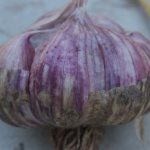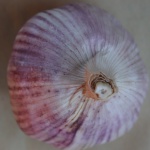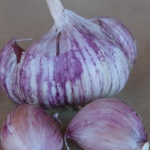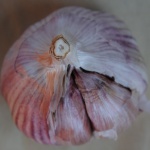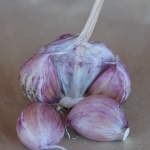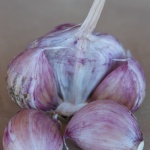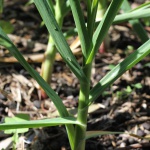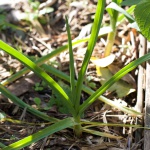Xian
Turban Group
Hardneck – Weakly Bolting
Xian is believed to have come from Xi’an in the Shanxi Province, China. Whether the cultivar sold in Australia under this name is directly derived from this source is not known but it is visually similar to cultivars with this name and derivation in the USA. Chester Aarons, the famous garlic grower and writer about all things garlic bought Xian in San Francisco’s China Town and he describes it as having intense heat when first eaten raw, followed by a rich, earthy, mushroomy finish.
General Information
| Other Names |
Xi'an |
| International Names |
Xian, Xi'an |
| Flavour |
Very hot on first taste, more mellow and earthy afterwards. |
| Storage |
Short, to 4 months. |
| Growing location |
Xian grows well in most states from Tasmania to Northern NSW and inland Southern Qld. Also Victoria, SA and Southern WA. |
| Growing requirements |
They like reasonably cold winters and hot dry summers. Plants will go quickly from being almost ready to past the best time to harvest. Watch them and harvest quickly when ready. |
| Planting and harvest |
Early to plant and early to harvest. |
Bulb
| Shape |
Bulbs are a flattened-globe shape with a flat to convex base.
|
| Skin colour and texture |
The skin is white to pale mauve and strongly purple striped and blotched. Skins are thin and break easily when dry.
|
Clove
| Number and layout |
7-10 cloves generally in a single layer but there may be 1 or more inner cloves.
|
| Size and shape |
Cloves are plump and blocky with blunt tips, 3cm tall and 2cm wide.
|
| Skin colour and texture |
The fine skin is relatively easy to peel and is pink with fine purple stripes.
|
Plant
| Size and shape |
Plants are generally smaller than some other Turbans although they will be stronger and more upright in regions with cold winters.
|
| Leaves |
Medium green to yellow-green, well spaced up the pseudostem. Folded in middle.
|
| Young plants |
Fast growing with lower leaves at a wide angle to the stem.
|
| Matures |
Plants mature rapidly near harvest. It's important to harvest quickly before the skins split.
|
| Scape |
Relatively strong scape although still classed as weakly bolting. Forms an upside-down U.
|
| Umbel and beak |
Umbel is turban shaped and the beak is of average length.
|
| Bulbils and flowers |
Bulbils are small to medium often 50+.
No flowers.
|
